Tactical missile system 2K5 "Kite"
At the beginning of the fifties, an original proposal appeared concerning the development of promising tactical missile systems and based on the characteristic features of systems of this class. At that time, there was no possibility of equipping missiles with control systems, because of which the calculated accuracy of firing at long ranges left much to be desired. As a result, it was proposed to compensate for the lack of accuracy by various methods. In the case of the first domestic tactical missile systems, accuracy was compensated for by the power of a special warhead. Another project had to use other principles.
In the next project it was proposed to use the approach inherent in multiple rocket launchers. The probability of hitting a particular target should have been increased by salvo firing with several missiles. Because of these features of the work and the proposed technical characteristics of the promising complex was to be a good combination of MLRS and tactical missile systems.
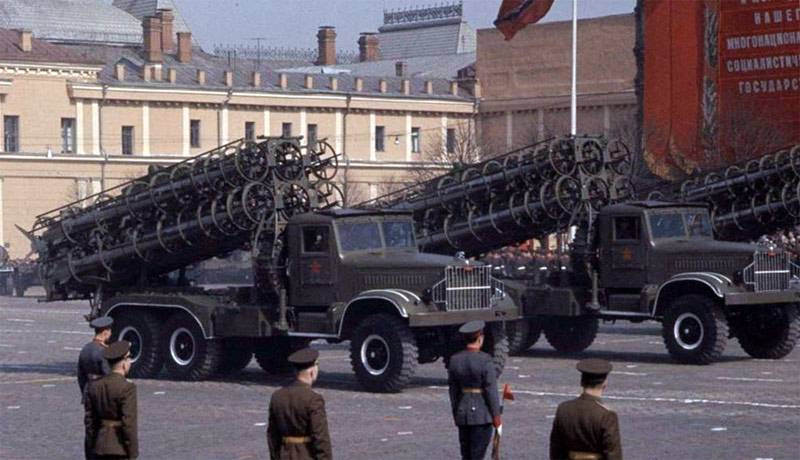
Complexes "Kite" on parade. Photo Militaryrussia.ru
The second unusual feature of the promising project was the class of engine used. All previous missile systems were equipped with ammunition equipped with solid-fuel engines. A new product with the aim of improving the basic characteristics of the proposed to complete the engine on liquid fuel.
Work on a new unguided ballistic missile with a liquid engine started in 1952 year. The design was carried out by specialists from OKB-3 NII-88 (Podlipky). The works were supervised by the chief designer DD. Sevruk. At the first stage of the work, the engineers formed the overall appearance of the prospective ammunition, and also determined the composition of the main units. After completion of the preliminary design, the design team presented a new development to the leadership of the military industry.
Analysis of the submitted documentation showed the prospects of the project. The proposed tactical missile system, designed for salvo firing, was of particular interest to the troops and could be used in the armed forces. 19 September 1953 was issued by a decree of the Council of Ministers of the USSR, according to which the OKB-3 NII-88 was to continue the development of a promising project. In addition, the list of subcontractors responsible for the creation of certain components of the complex was specified.
A promising tactical missile system received the Kite cipher. Subsequently, the Main Artillery Directorate assigned the project the index 2К5. The rocket complex "Kite" received the designation 3Р7. The system should have been self-propelled launcher. At different stages of development and testing, this combat vehicle received the designations CM-44, BM-25 and 2P5. The artillery part of the self-propelled launcher was designated as CM-55.
During the preliminary work on the project, the main method of combat use of promising missile systems was formed. Korshun systems had to independently advance to the indicated positions, and then, using two or three batteries, simultaneously strike at the enemy’s defenses at the required depth. The results of such attacks should have been the overall weakening of the enemy’s defenses, as well as the appearance of corridors for advancing the attacking troops. It was assumed that a relatively large firing range and the power of combat units would allow the enemy to cause significant damage and thereby facilitate the advance of their troops.
The intended method of using the 2K5 complex “Kite” meant the rapid transfer of equipment to the required firing positions, which imposed corresponding requirements for self-propelled launchers. This technique was decided to build on the basis of one of the newest automobile chassis with the required indicators of carrying capacity and throughput. The best performance among the existing models was shown by the YAZ-214 three-axle all-wheel-drive truck.
This car was developed by the Yaroslavl Automobile Plant in the early fifties, but it went into series only in 1956. Production in Yaroslavl continued until the 1959 year, after which YAZ was transferred to the production of engines, and the construction of trucks continued in the city of Kremenchug under the name KrAZ-214. The Kite complex could use both types of chassis, however there is reason to believe that serial equipment was built primarily on the basis of Yaroslavl machines.
YAZ-214 was a three-axle truck bonnet layout with the wheel formula 6 х6. The car was equipped with a YAZ-206B diesel engine with 205 horsepower. and manual transmission based on a five-speed gearbox. A two-stage transfer case was also used. With its own weight of 12,3 t, the truck could carry cargo up to 7 t. There was the possibility of towing trailers of greater weight, including road trains.
During the restructuring project CM-44 / BM-25 / 2P5, the base car chassis received some new units, primarily the CM-55 launcher. A support platform was fastened on the cargo area of the car, on which a swivel unit with a hinge was placed to install the guide package. In addition, in the rear of the platform, there were lowered outrigger supports designed to stabilize the machine during firing. Another refinement of the base machine was to install shields covering the windshield during firing on the cab.

Rocket 3P7 in the cut. Figure Militaryrussia.ru
The artillery part of the CM-55 launcher, developed in 1955 by the Leningrad TsKB-34, was a platform with mounts for the swing pack of guides. Due to the available drives, the platform could be induced horizontally, turning on the 6 ° to the right and left of the longitudinal axis of the combat vehicle. In addition, the possibility of vertical guidance package guides with a rise at an angle of up to 52 °. At the same time, due to a small sector of horizontal guidance, shooting was carried out only forward, “through the cabin,” which to some extent limited the minimum angle of elevation.
On the rocking device launcher fastened package guide for unguided missiles. The package was a device of six guides, arranged in two horizontal rows of three. On the outer surface of the central guides there were frames needed to connect all the units into a single unit. In addition, the main power elements and hydraulics of package guidance were also located there. The package of guides was equipped with an electrical ignition system, controlled from the console in the cabin.
As part of the CM-55, standardized guides of relatively simple construction were used. To launch a rocket, it was proposed to use a device of ten rings-clips connected by longitudinal beams. On the inner racks of the rings were fastened four screw guides, with which the initial promotion of the rocket was carried out. Due to the specific distribution of loads when firing, the rings were located with different intervals: with smaller ones in the “muzzle” part and with larger ones in the “breech”. At the same time, in connection with the design of the rocket, the screw guides were not attached to the rear ring and connected only with the following.
After installing all the necessary equipment, the mass of the 2P5 launcher reached 18,14 t. With such a weight, the combat vehicle could reach speeds up to 55 km / h. Power reserve exceeded 500 km. All-wheel drive chassis provided movement over rough terrain and overcoming various obstacles. The combat vehicle had the ability to move with ready-to-use ammunition.
The development of the Kite complex began in 1952 with the creation of an unguided rocket. In the future, this product received the designation 3P7, under which it was brought to the test and mass production. The 3P7 was an unguided ballistic missile with a liquid engine capable of hitting targets over a fairly wide range of ranges.
In order to increase the firing range, the authors of the 3P7 project had to maximize the aerodynamics of the rocket. The main means of improving these characteristics was a large lengthening of the body, which required the abandonment of the waste assembly of the aggregates. Thus, instead of concentric placement of the fuel and oxidizer tanks, tanks should be used that are located in the housing one after another.
The 3P7 rocket was divided into two main units: the combat and jet parts. A conical head fairing and part of a cylindrical body were placed under the warhead, and the components of the power plant were placed directly behind it. Between the combat and reactive parts there was a small compartment designed for their docking, as well as to provide the required weight of the product. During the assembly of the rocket, metal disks were placed in this compartment, with the help of which the mass was adjusted to the required values with an accuracy of 500 g. In assembled form, the rocket had an elongated cylindrical body with a conical head fairing and four trapezoid stabilizers in the tail. Stabilizers mounted at an angle to the axis of the rocket. Pins were placed in front of the stabilizers to interact with the screw guides.
The total length of the 3P7 rocket was 5,535 m, the case diameter is 250 mm. The reference starting weight was 375 kg. Of these, 100 kg accounted for the warhead. The total mass of fuel and oxidizer reached 162 kg.
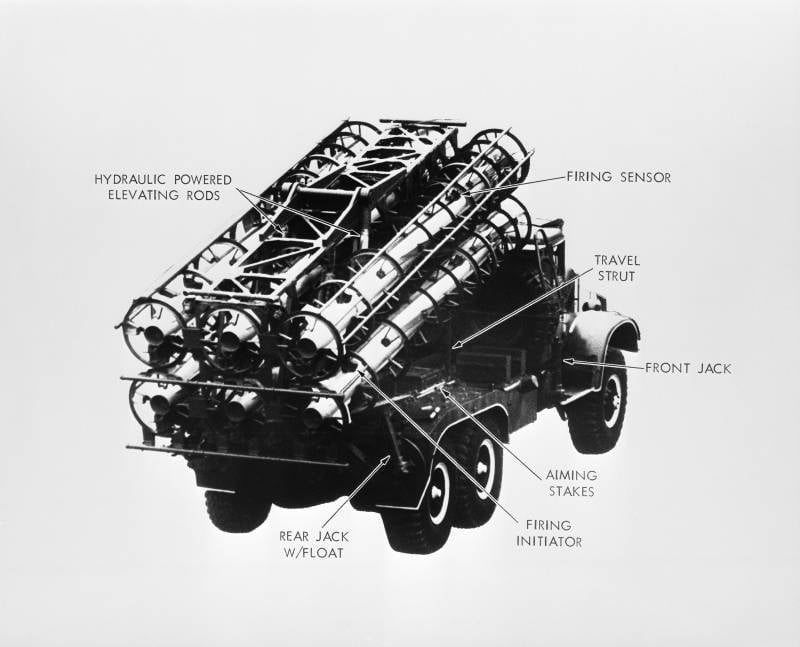
Scheme of the complex 2K5 "Kite" from a foreign reference book on Soviet weapons. Figure Wikimedia Commons
Initially, the C3 liquid engine and fuel and oxidizer tanks were to be located in the reactive part of the 7P3.25 product. Such a power plant was supposed to use TG-02 fuel and an oxidizing agent in the form of nitric acid. The used fuel vapor ignited independently and then burned, providing the necessary traction. Even before the completion of the design of the rocket, calculations showed that the first version of the power plant was too expensive to manufacture and operate. To reduce the cost, the rocket was equipped with a C3.25B engine using TM-130 non-flammable fuel. At the same time, some amount of TG-02 fuel was kept to start the engine. The oxidant remained the same - nitric acid.
With the help of the existing engine, the rocket had to go off the launcher, and then go through the active part of the flight. The production of the entire fuel and oxidizer supply required 7,8 s. When descending from the guide, the speed of the rocket did not exceed 35 m / s, at the end of the active section - up to 990-1000 m / s. The length of the active section was 3,8 km. The impulse received during acceleration allowed the rocket to reach the ballistic trajectory and hit the target at a distance of up to 55 km. Flight time to the maximum range reached 137 with.
To hit a target, a high-explosive warhead was proposed with a total weight of 100 kg. Inside the metal case, an 50-kg explosive charge and two fuses were placed. In order to increase the probability of hitting a target, head contact and bottom electromechanical fuses were used.
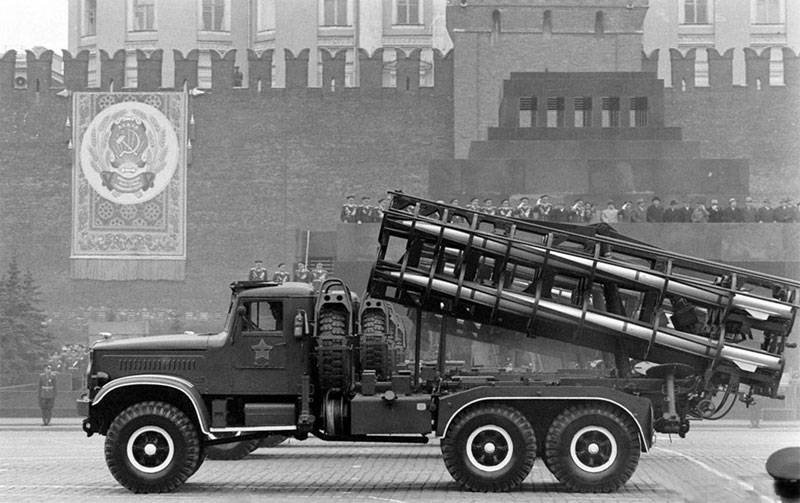
The passage of the parade through the mausoleum. Photo Militaryrussia.ru
The rocket had no control systems. Targeting should have been done by setting the required guidance angles for the package of guides. By turning the launcher in the horizontal plane, azimuth guidance was performed, and the inclination of the systems changed the trajectory parameters and, as a result, the firing range. When firing at a maximum range, the deviation from the aiming point reached 500-550 m. It was planned to compensate for such low accuracy with volleys from six missiles, including from several combat vehicles.
It is known that during the development of the Kite project, the 3P7 rocket became the basis for special-purpose modifications. In 1956, the small meteorological rocket MMP-05 was developed. It differed from the basic product by increased dimensions and weight. Due to the new head compartment with equipment, the length of the rocket has grown to 7,01 m, weight - to 396 kg. In the instrument compartment there was a group of four cameras, as well as thermometers, manometers, radio electronic and telemetry equipment, similar to the MP-1 installed on the rocket. Also, the new missile received a radar responder to track the flight path. By changing the parameters of the launcher, it was possible to fly along a ballistic trajectory as high as 50 km. In the final section of the trajectory, the equipment descended to the ground with a parachute.
In 1958, the MMP-08 meteorological rocket appeared. She was about a meter longer than the MMP-05 and weighed 485 kg. An existing instrument compartment with the necessary equipment was used, and the difference in size and weight was due to the increased fuel reserve. Due to the greater amount of fuel and oxidant, MMP-08 could rise to an altitude of 80 km. In terms of performance, the rocket hardly differed from its predecessor.
The development of the 3P7 unguided tactical missile was completed in the 1954 year. In July, 54-th held the first launch of an experimental product from the test bench. After the launch of serial production of the YAZ-214 vehicles, the participants of the Kite project had the opportunity to build an experimental self-propelled launcher of the 2P5 type. The manufacture of such a machine made it possible to begin testing the entire missile system. Field inspections confirmed the calculated characteristics of the new weapons.
In the 1956 year, according to test results, the tactical missile system 2K5 "Kite" was recommended for mass production. Assembly of military vehicles was assigned to Izhevsk engineering plant. In 1957, contractors sent the first mass-produced missile launchers and unguided missiles for them to the armed forces. This equipment entered trial operation, but was not accepted for service. On November 7, Korshun complexes took part in the parade on Red Square for the first time.
During the trial operation of new tactical missile systems, some drawbacks were identified that seriously hampered their use. First of all, the claims were caused by the low accuracy of the missiles, together with the low power of the high-explosive warhead, which worsened the effectiveness of the weapon. A deviation to 500-550 m at maximum range was acceptable for missiles with special warheads, but the 50-kilogram conventional charge could not provide an acceptable target loss with such accuracy.
It also turned out that the 3P7 rocket has insufficient reliability when used in certain weather conditions. At low air temperatures, equipment failures were observed, right up to explosions. This feature of the weapon dramatically reduced the possibilities for its use and interfered with normal operation.
The identified shortcomings did not allow to fully use the newest missile system, and also did not leave the possibility to put into practice all its advantages. For this reason, upon completion of trial operation, it was decided to abandon the further production and use of "Kites". In August, 1959, and in February, 1960, two resolutions of the Council of Ministers were issued, stipulating the shutdown of the mass production of components of the 2K5 “Kite” complex. In less than three years, no more than a few dozen self-propelled launchers and several hundred missiles were built.
In the 1957 year, almost simultaneously with the start of the pilot operation of the Kors, the scientists "adopted" the small meteorological rocket MMP-05. The first working launch of such a product took place on November 4 at the rocket sounding station located on Hays Island (Franz Josef Land Archipelago). Before 18 February, 1958-th meteorologists at this station conducted five more similar studies. The operation of meteorological rockets was carried out at other stations. Of particular interest is the launch of the MMP-05 rocket, which took place on the last day of 1957. The launch pad for the Ob ship, which stood on the traverse of the recently opened Mirny station in Antarctica, became the launching pad for the rocket.
The operation of the MMP-08 missiles began in the 1958 year. These products were used by scientists from various meteorological laboratories, primarily located in high latitudes. Until the end of the fifties, polar weather stations used only rockets created on the basis of the 3P7 product. Three missiles were used in the 1957 year, 58 in the 36, and 59 in the 18. In the future, the MMP-05 and MMP-08 rockets were replaced by newer developments with improved characteristics and modern target equipment.
Due to the inadequate characteristics of the rocket and the complex as a whole, in 1959-60, it was decided to stop the further operation of the Korn 2K5 systems. Until that time, the tactical missile system was never adopted, remaining in trial operation, which showed the impossibility of its full service. The lack of real prospects led to the abandonment of the complex with the subsequent decommissioning and disposal of equipment. The cessation of the release of 3P7 missiles also entailed stopping the production of the MMP-05 and MMP-08 products, but the stock created allowed to continue operation until the middle of the next decade. According to some reports, at least 1965 of MMP-260 missiles and more than 05 of MMP-540 were used before 08.
Almost all self-propelled launchers 2P5 were written off and went to the cutting or re-equipment. No longer needed ballistic missiles were disposed of. According to reports, only one 2P5 / BM-25 machine has been preserved in its original form and is now an exhibit of the Military Historical Museum of Artillery, Engineering and Communication Troops (St. Petersburg). Along with the war machine, the museum displays several models of 3P7 rockets.
Project 2K5 "Kite" was an original attempt to combine in one complex all the advantages of multiple launch rocket systems and tactical ballistic missiles. From the first, it was proposed to take the possibility of simultaneously launching several missiles, allowing them to hit targets on a fairly large area, and from the second, firing range and tactical purpose. Such a combination of the qualities of different classes of equipment could give certain advantages over existing systems, however, the design flaws of the 3P7 rockets did not allow to realize all the existing potential. As a result, the Kite complex has not gone out of the trial operation stage. It should be noted that in the future such ideas were nevertheless implemented in the new long-range MLRS projects that came into service later.
Based on:
//russianarms.ru/
//dogswar.ru/
//rbase.new-factoria.ru/
//militaryrussia.ru/blog/topic-194.html
Shirokorad A.B. Domestic mortars and rocket artillery. - Mn., Harvest, 2000.
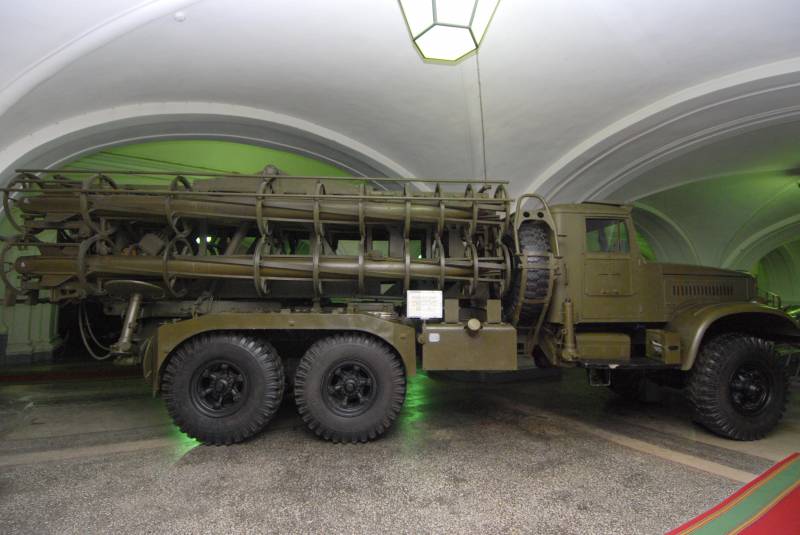
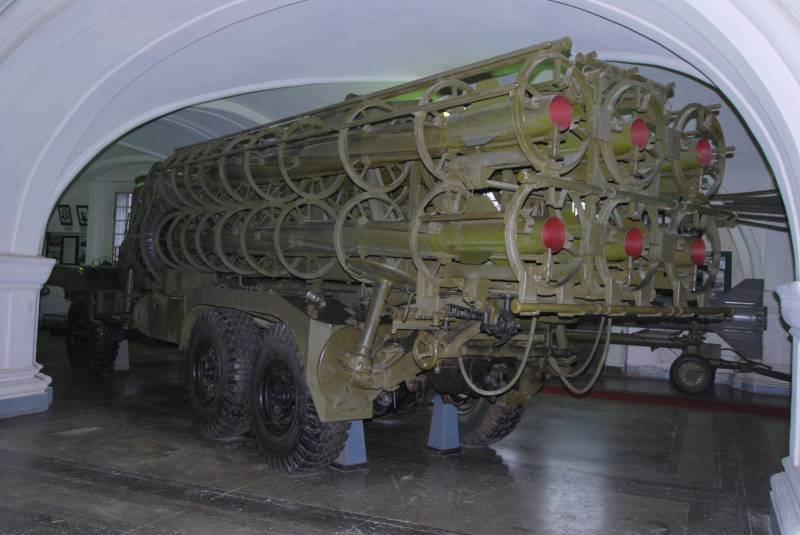
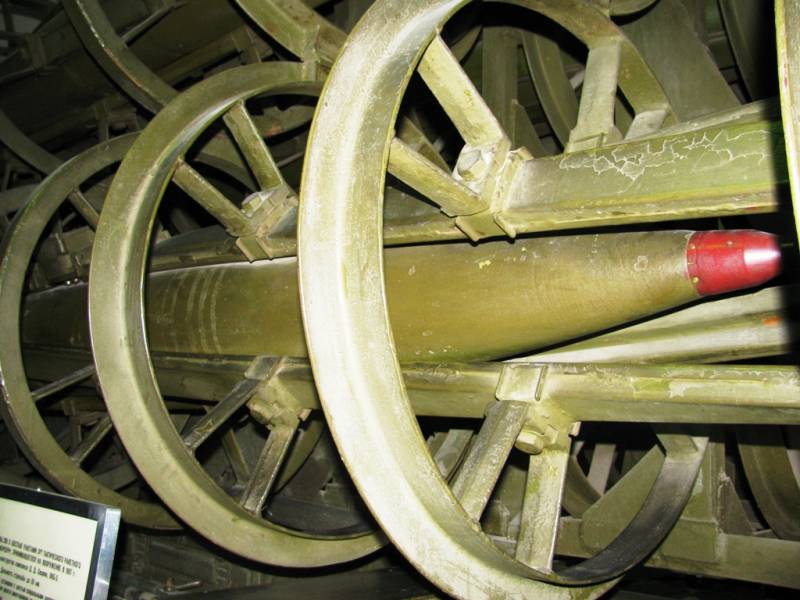
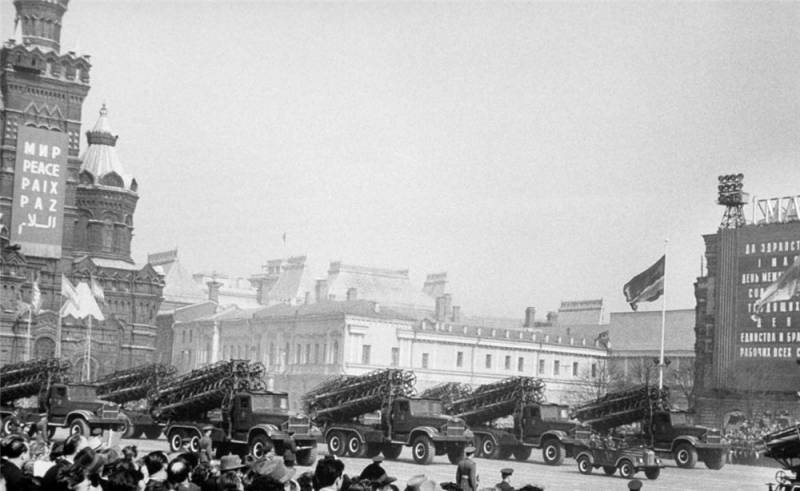
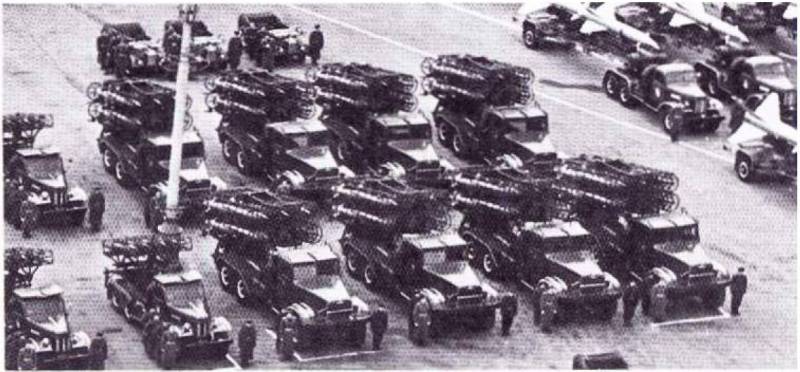
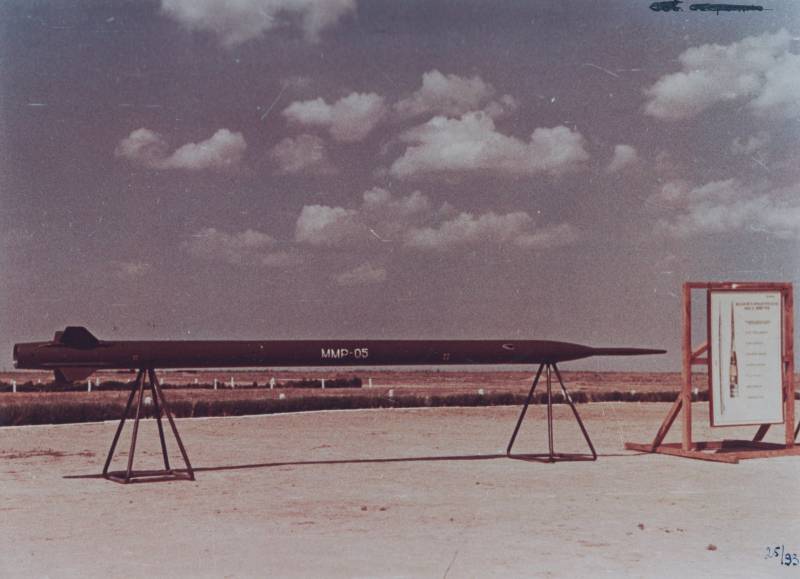
Information